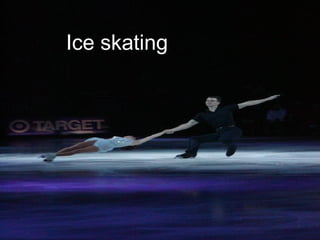ice skating
- 1. Ice skating
- 2. Figure skating Figure skating is an athletic sport in which individuals, pairs, or groups perform spins, jumps, footwork and other intricate and challenging moves on ice
- 3. Disciplines Singles competition for men and women (who are referred to as "ladies" in ISU rulebooks), wherein skaters perform jumps, spins, step sequences, spirals, and other elements in their programs. Pair skating teams consist of a woman and a man. Pairs perform singles elements in unison as well as pair-specific elements such as throw jumps, in which the man 'throws' the woman into a jump; lifts, in which the woman is held above the man's head in one of various grips and positions; pair spins, in which both skaters spin together about a common axis; death spirals, and other elements. Ice dancing is again for couples consisting of a woman and a man skating together. Ice dance differs from pairs in focusing on intricate footwork performed in close dance holds, in time with the music. Ice dance lifts must not go above the shoulder.
- 4. Singles
- 5. Pair skating
- 6. Ice dancing
- 7. Competition format and scoring The International Skating Union (ISU) is the governing body for international competitions in figure skating, including the World Championships and the figure skating events at the Winter Olympic Games . In singles and pairs figure skating competition, competitors must perform two routines, the "short program", in which the skater must complete a list of required elements consisting of jumps, spins and steps; and the "free skate" or "long program", in which the skaters have slightly more choice of elements. Ice dancing competitions usually consist of three phases: one or more "compulsory dances"; an "original dance" to a ballroom rhythm that is designated annually; and a "free dance" to music of the skaters' own choice.
- 8. Equipment Figure skates Figure skates differ from hockey skates most visibly in having a set of large, jagged teeth called toe picks (also called "toe rakes") on the front of the blade. The toe picks are used primarily in jumping and should not be used for stroking or spins. Blades are mounted to the sole and heel of the boot with screws. Typically, high-level figure skaters are professionally fitted for their boots and blades at a reputable skate shop in their area. Ice dancers' blades are about an inch shorter in the rear than those used by skaters in other disciplines, to accommodate the intricate footwork and close partnering in dance.
- 9. Clothing For practice skating, figure skaters often wear leggings , tight fitting, flexible pants. In competition, women may wear skirts or pants, though skirts are far more popular. Women generally wear opaque flesh-coloured leggings or tights under dresses and skirts, which may extend to cover their skates. Men must wear pants and may not wear tights. Competition costumes for skaters of both sexes can be theatrical and heavily beaded or trimmed, and can cost thousands of dollars if designed by a top-level costumemaker. Although the use of flesh-colored fabric means the costumes are often less revealing than they may appear, there have been repeated attempts to ban clothing that gives the impression of "excessive nudity" or that is otherwise inappropriate for athletic competition.Many skaters also wear theatrical makeup and hairstyles during competitions.
- 10. Rink equipment Some rinks use harness systems to help skaters learn jumps in a controlled manner. The ice rink installs a heavy-duty cable that is securely attached to two walls of the rink. A set of pulleys ride on the cable. The skater wears a vest or belt that has a cable or rope attached to it. That cable/rope is threaded through the movable pulley on the cable above. The coach holds the other end of the cable and lifts the skater by pulling the cable/rope. The skater can then practice the jump, with the coach assisting with the completion.










